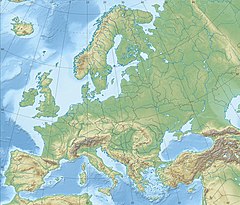| Grotte de Scladina | |
 Scladina Center Scladina Center | |
  | |
| Alternative name | Sclayn Cave |
|---|---|
| Location | near village of Sclayn, Province of Namur |
| Region | Andenne, Belgium |
| Coordinates | 50°29′2″N 5°1′32″E / 50.48389°N 5.02556°E / 50.48389; 5.02556 |
| History | |
| Material | limestone |
| Periods | Palaeolithic |
| Associated with | Neanderthals |
| Site notes | |
| Excavation dates | since 1971 |
| Archaeologists | of ASBL Archéologie Andennaise |
Scladina, or Sclayn Cave, is an archaeological site located in Wallonia in the town of Sclayn, in the Andenne hills in Belgium, where excavations since 1978 have provided the material for an exhaustive collection of over thirteen thousand Mousterian stone artifacts and the fossilized remains of an especially ancient Neanderthal, called the Scladina child were discovered in 1993.
Scladina cave site
The Scladina cave is located on a hill to the right of the Meuse river bank, south-west of Sclayn village, being one of a number of caves in the middle Meuse river region, where significant paleontological discoveries were made as in the Spy Cave and the Lyell Cave. The caves in the area have undergone systematic exploration since 1949.
Scladina Cave was discovered in 1971 by cavers of the CAS (Archaeological Circle Sclaynois). In 1978 the Scientific Council of the Prehistory Department of the University of Liège began to direct the excavations. Since the site has yielded numerous artifacts of Mousterian Neanderthal origin, amidst assemblages of stone tools, bones and faunal remains. After the initially clearing of the entrance the excavations uncovered two strata of Neanderthal occupation, the oldest dating back 130,000 years. The sediments yielded artifacts and Mousterian stone tools, the earliest were attributed to the Middle Palaeolithic. The lithic industry of layer 5 is considered to be instrumental for a deeper understanding of the Mousterian settlements in the region and future studies might support the acquisition of a more accurate chronology and help to draw a more complete image of the contemporary environment of the site.
The remarkably good state of preservation of the fossils, faunal remains and the sediments have the site allowed to become a point of reference in climatic evolution studies of Palaeolithic north-western Europe. Two Neanderthal occupation sites were identified, one dated to be 130,000 years old and the other 40,000 years. Modern humans infrequently occupied the site between 32,000 and 9,000 years ago and used the site as a burial place during the late Neolithic and Bronze Age between 5,300 and 2,000 years ago. Continued excavations since 1978 have produced a steady stream of findings that culminated in the discovery of the remarkable Sclayn child fossils in 1993. Sclayn cave site has been classified as a national heritage site of Wallonia on 27 May 2009 and is since open to the public.
Scladina Neanderthal child
Dated to be around 127,000 years old, the first fragment of the now nearly complete mandible, was found on 16 July 1993. A maxillary fragment and several teeth of the child were excavated in subsequent campaigns. A genetic sample was successfully extracted from one of the molars at a specific laboratory for ancient DNA and analyzed at the Max Planck Institute for Evolutionary Anthropology, Leipzig.
Physiology and development
The child's DNA is one of the oldest to have been extracted from a Homo neanderthalensis fossil and has significantly contributed to the genetic mapping of the Neanderthal genome and the comparison with Homo sapiens. Initially it was suggested that the Scladina child was 2 to 4 years older than current estimates, based upon traditional assessments of the progressive dental development. Results of an international research collaboration allow the proposal that Homo neanderthalensis children had a faster rate of dental development than modern human children as well as other aspects of physical development were likely to be more rapid in juvenile Neanderthals, such as a quicker onset of sexual maturity and different and faster patterns of early cognitive development.
The study further elaborates, that tooth development is related to overall physiological development, noticeable as the first molar eruption coincides - universally across the primate phylum - with the beginning of the weaning stage, whereas the upsurge of the third molar indicates the onset of sexual development. Some scholars, though debate universal periods of anterior tooth growth, as it is known that anterior tooth growth takes longer in great apes than in humans and varies among human populations. The study of the child turned out to support the idea that extremely prolonged duration of human development is unique to Homo sapiens and a relatively recent development in human evolution. Although the matter is still debated, the more rapid development apparent in Homo neanderthalensis children (wherein sexual onset may have occurred up to 4 years sooner) puts Neanderthal development patterns at a progressive stage in between modern Homo sapiens and that of earlier species, such as Homo erectus. This trend suggests to many scientists the necessary prevalence of differing patterns of behavioral and social development as well.
A single tooth of another Neanderthal infant, also found at the site, was analysed by Christine Austin and Tanya Smith, whose analysis suggests that this particular child has received 7 months of breastfeeding and supplementation for additional 7 months, which adds up to roughly 14 months of breastfeeding. This cycle is indeed longer than that of some contemporary human cultures, which implies that Neanderthal children might have grown up faster, a process that began only after the stages of early infancy.
Behavior and tool use
Neanderthal diet consisted to over 70% of meat, unlike that of contemporary Homo sapiens hunter-gatherer societies. although some cooked vegetables are evident. Provisioning techniques, made superior by extensive tool use, aided early Homo in pursuits of worldwide expansion. One large game evident in the diets of Scladina Neanderthals is bear. Several bear bones were found amongst other stone tools and modifiers within the Scladina cave site. Wear marks on the bones, 4 of the 6 bear bone tools which originated from a single femur, exhibit abrasion traits that classify them as lithic retouchers.
Public education
The ASBL Archéologie Andennaise has established an educational mission in consequence of the prolonged, intense and insightful study of the site and the enormous implications of the acquired information and data. The idea is to correctly inform about prehistory, deemed to be still perceived as nebulous and mythical by the general public. The site and its documentation center are open to the public all year round. Private groups, school classes are permanently granted access to the cave, the laboratory, the museum gallery with multimedia program rooms, accompanied by the researchers and scientists themselves.
See also
References
- ^ Di Modica, Kévin; Bonjean, Dominique (September 2006). "The exploitation of quartzite in Layer 5 (Mousterian) of Scladina cave (Wallonia, Belgium): flexibility and dynamics of concepts of debitage in the Middle Palaeolithic". XV World Congress of the International Union for Prehistoric and Protohistoric Sciences. BAR International Series. Vol. 1998. Archaeopress. pp. 33–41.
- ^ Orlando, Ludovic; Darlu, Pierre; Toussaint, Michel; Bonjean, Dominique; Otte, Marcel; Hänni, Catherine (June 2006). "Revisiting Neandertal diversity with a 100,000 year old mtDNA sequence". Current Biology. 16 (11): R400 – R402. CiteSeerX 10.1.1.618.1413. doi:10.1016/j.cub.2006.05.019. PMID 16753548. S2CID 588358.
- "100,000 Year-old DNA Sequence Allows New Look At Neandertal's Genetic Diversity". ScienceDaily (Press release). 7 June 2006.
- ^ "WALLONIE.MUSEUM - Scladina Cave and Archaeological Centre". Portail.wallonie.museum. Retrieved 23 January 2017.
- Bocherens, Hervé; Billiou, Daniel; Patou-Mathis, Marylène; Bonjean, Dominique; Otte, Marcel; Mariotti, André (November 1997). "Paleobiological Implications of the Isotopic Signatures (13C,15N) of Fossil Mammal Collagen in Scladina Cave (Sclayn, Belgium)". Quaternary Research. 48 (3): 370–380. Bibcode:1997QuRes..48..370B. doi:10.1006/qres.1997.1927.
- Bates, Martin; Bates, Richard; Blinkhorn, Ed; Gamble, Clive; McNabb, John; Julien, Marie Anne; Pope, Matt; Shaw, Andy (2014). "Neanderthals of the Channel River Valley: New Research at La Cotte de St Brelade, Jersey". Middle Palaeolithic in North-West Europe: Multidisciplinary Approaches: Book of Abstracts (Abstract). p. 9. doi:10.13140/2.1.4426.9769.
- "UNCOVERING THE SECRETS OF SCLADINA CAVE" (PDF). ah.viu.ca. Retrieved 23 January 2017.
- ^ Smith, Tanya M.; Toussaint, Michel; Reid, Donald J.; Olejniczak, Anthony J.; Hublin, Jean-Jacques (18 December 2007). "Rapid dental development in a Middle Paleolithic Belgian Neanderthal". Proceedings of the National Academy of Sciences of the United States of America. 104 (51): 20220–20225. Bibcode:2007PNAS..10420220S. doi:10.1073/pnas.0707051104. PMC 2154412. PMID 18077342.
- Andrea Thompson (4 December 2007). "Neanderthals Grew Up Faster than Humans". Live Science.
- Stringer, Chris (13 March 2012). Lone Survivors: How We Came to Be the Only Humans on Earth. Henry Holt and Company. pp. 73–. ISBN 9780805088915. Retrieved 1 June 2014.
- "Neanderthal bearing teeth". Max-Planck-Gesellschaft (Press release). 4 December 2007.
- Austin, Christine; Smith, Tanya M.; Bradman, Asa; Hinde, Katie; Joannes-Boyau, Renaud; Bishop, David; Hare, Dominic J.; Doble, Philip; Eskenazi, Brenda; Arora, Manish (13 June 2013). "Barium distributions in teeth reveal early-life dietary transitions in primates". Nature. 498 (7453): 216–219. Bibcode:2013Natur.498..216A. doi:10.1038/nature12169. PMC 3725337. PMID 23698370.
- El Zaatari, Sireen; Grine, Frederick E.; Ungar, Peter S.; Hublin, Jean-Jacques (October 2011). "Ecogeographic variation in Neandertal dietary habits: Evidence from occlusal molar microwear texture analysis". Journal of Human Evolution. 61 (4): 411–424. doi:10.1016/j.jhevol.2011.05.004. PMID 21719068.
External links
- Scladina Cave Archaeological Center (in French)
- The Scladina cave Archéologie Andennaise
- Charters, Daniel; Brown, Richard P.; Abrams, Grégory; Bonjean, Dominique; De Groote, Isabelle; Meloro, Carlo (February 2022). "Morphological evolution of the cave bear (Ursus spelaeus) mandibular molars: coordinated size and shape changes through the Scladina Cave chronostratigraphy". Palaeogeography, Palaeoclimatology, Palaeoecology. 587: 110787. Bibcode:2022PPP...587k0787C. doi:10.1016/j.palaeo.2021.110787. S2CID 245058872.
| Neanderthal | |||||||||
|---|---|---|---|---|---|---|---|---|---|
| Ancestors | |||||||||
| Biology | |||||||||
| Tool traditions | |||||||||
| Regional variants | |||||||||
| Notable specimens |
| ||||||||
| Fossils with claimed Neanderthal traits |
| ||||||||
| Contemporary species | |||||||||
| Research | |||||||||
| Popular culture | |||||||||
| Documentaries | |||||||||